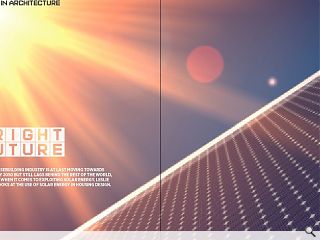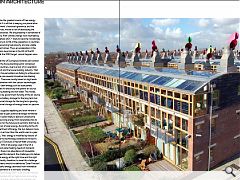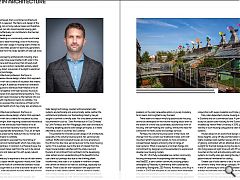Solar Architecture: Bright Future
5 Oct 2022
The UK housebuilding industry is at last moving towards net zero by 2050 but still lags behind the rest of the world, especially when it comes to exploiting solar energy. Leslie Howson looks at the use of solar energy in housing design.
The sun will always be the greatest source of free energy available to mankind. It is all that is keeping our planet alive. Yet, because of mankind`s historical ignorance, and the burning of its resources, we are at risk of destroying the planet and with it, ourselves. We are presently in somewhat of an energy dichotomy. With climate change now overheating the northern hemisphere (40C + likely to become increasingly common) yet as many as 13.5% of the population in countries such as the UK, experiencing fuel poverty, and are unable to afford to heat their homes. Thus, an acceleration in the number of zero carbon new homes in the UK (of the 30 million total) to meet the 2050 target, cannot happen soon enough.
Critics argue that the UK’s progress towards zero carbon is especially slow in the house building sector compared to many European countries, due to a lack of co-operation between government and the house building industry. That is not to say that UK house builders are failing to achieve zero carbon, for there are now several innovative trail-blazing schemes underway. These are mostly based on high levels of insulation in combination with low carbon technologies that provide cheap, clean energy such as solar panels incorporated on roofs for electricity that power air source heat pumps providing heating and hot water. This model, perhaps encouraged by government funding of the air source heat pumps, relies on battery storage for the long term but the potential for thermal storage for the long term ignoring the potential for thermal storage of energy based on passive design principles.
With oil and gas supplies depleting and even where in abundance being used to gain political leverage worldwide and with the nuclear option likely to leave an unwelcome long-term legacy, sourcing energy from renewables has to be a preferred option for the future and central to that has to be greater exploitation of solar energy. According to the US Government`s Department of Energy, the Sun delivers more energy to the earth in an hour than the world uses in a year albeit this abundant, ‘free’ energy is modified by factors of location, season and the technology available to harvest it.
Professor Tadhg O’Donovan of Heriot-Watt University, Dubai, said: “Nearly 30% of all energy used in the UK is to meet the space and water heating needs of domestic dwellings and while there is an abundance of renewable (solar) energy to meet this demand, the challenge is to deliver useful energy; that is energy at the right time and the right temperature. Importantly, therefore, to meet this challenge the correct target metric should be defined as ‘Solar Fraction’. This is the ratio of useful energy delivered from renewable solar to the energy demand of a domestic dwelling. Renewable Energy Technology (RET) such as solar thermal, solar photovoltaic coupled with air heat pumps and energy storage (sensible and phase change thermal storage) can currently address much of Solar Fraction but if 100% Solar Fraction is to be achieved, then a combined architectural and RET approach is required. The fabric and design of the domestic dwelling can not only reduce losses and therefore overall demand but can also maximise solar energy gain which if managed effectively can contribute to the thermal comfort of the internal space.”
Solar district heating on a community scale could make significant in-roads to ease the energy crisis in the housing sector but until then solar usage in housing seems limited to roof-mounted photovoltaic panels for electricity generation, leaving the potential from the wider benefits of solar yet to be realised.
For decades, pioneering professionals including a few architects worldwide, have experimented with solar in the northern hemisphere and have proven that all newly built houses can achieve zero carbon credentials entirely reliant on solar energy by direct conversion of sunlight to electrical power and by thermal storage.
Within the architectural profession, the focus is increasingly on Passive House design; a fabric-first approach to building design with strict criteria of insulation that means keeping houses airtight. A balanced mechanical ventilation system is then required to distribute fresh filtered air to all rooms of the home together with heat recovery to ensure that the air is delivered at an appropriate temperature. Thus, an air-tight approach seeks to preserve the heat put into our homes together with mechanical means to ventilate. The Covid-19 pandemic exposed the importance of fresh air for physical and mental health which may imply less emphasis on air tightness.
Within the architectural profession, the focus is increasingly on Passive House design; a fabric-first approach to building design with strict criteria for insulation but also keeping houses airtight, then requiring a balanced mechanical ventilation system that distributes fresh filtered air to all rooms of the home and heat recovery to ensure that the air is delivered at an appropriate temperature. Thus, an air-tight approach seeks to preserve the heat put into our homes but then mechanical means to ventilate.
The Covid-19 pandemic exposed the importance of fresh air for physical and mental health which may imply less emphasis on air tightness. In contrast, in a Passive House, the Passive Solar approach takes heat from the sun to be stored in the building fabric and balances this with purely natural ventilation systems.
The building industry’s response to the use of solar seems to be confined to a quasi-retrofit approach mostly with Solar PV panels fixed to the roofs of conventional standard house types. So even though there is a drive to achieve net zero in all housing by 2050, solar-dependent housing within the volume housing sector is still limited.
Solar technology has been around for decades but despite over 50 years of proof that in the UK, such as Passive Solar design technology coupled with associated solar systems are technically and economically viable, neither the architectural profession nor the building industry has yet sought to commit to wholly solar. Yet it has been proven and documented in such as `Solar Architecture in Cool Climates` by Colin Porteous and Kerr Macgregor, that solar architecture including adopting passive solar design principles, is a viable alternative, even in countries like Scotland.
The potential for innovative solar usage in UK architecture, especially in the volume housing sector, has yet to be fully realised. 100% solar-powered houses are now emerging in the UK but too few have yet carried over to the mass housing sector. This is perhaps due to the lack of interest from the major house builders satisfied with the status quo and the lack of commitment from architects to the developing solar options and an understanding of the benefits to the user client but perhaps also due to the thinking, albeit misinformed, that solar is un-suitable in northern climates and cannot be relied on to heat our buildings, especially our homes. There is also an over-obsession with payback from investing in solar panel systems. When it comes to coping with climate change such as the unstoppable inevitability of the huge Greenland ice shelf melt due to impact on sea levels, entirely due to human CO2 emissions, then simply measuring payback on the solar renewable option, in purely monetary terms seem short-sighted to say the least.
There seems no reason why fully passive solar housing cannot be developed for the volume housing sector even to the extent of a more fully sustainable, autonomous form of housing, with self-heating and cooling, without the need for connection to mains power and sewage services.
Perhaps, the volume housing sector of the future will change from the current neo-traditional model, with roof-mounted retrofit style solar panels, to more innovative concept-based designs embracing the full range of solar systems. What is required is a mindset change and commitment by designers and house builders to explore and develop new housing models.
The UK`s first fully sustainable low-carbon community housing development Incorporating solar technology was BedZED, a zero-carbon community housing project developed by Peabody in partnership with sustainability consultancy Bioregional, ZED Factory Architects, and Arup in London in 2002 and designed to use energy from renewable only sources generated on site. This took a passive solar approach with a significant commitment to energy generated from solar panels and high levels of thermal mass, all in conjunction with super-insulation and triple glazing.
Fully solar-dependent volume housing is possible even in Scotland and on a commercial basis. A preliminary design study for passive solar housing for the Scottish Climate modelled by Heriot-Watt University in 2016, proved the viability of such housing using passive solar and other solar systems.
Houses based on an economical design offering variable storey heights, using off-site pre-fabrication and comprising highly insulated cold weather spaces with a low percentage of glazing, contrasted with an attached atrium, can absorb sunlight for thermal storage during the day to be released into living spaces at night time and with PV and PVT panels mounted on the roof and atria along with solar shading systems to modify solar gain during the day time and with passive natural ventilation for cooling.
Greater use of solar seems to be a ‘no brainer` and could be central to many more design concepts. With energy bills in the UK continuing to climb to unaffordable levels for the average householder, then less reliance on mains services for energy by making better use of the constant free energy from the sun must now be more seriously explored as part of our future energy strategy for all forms of housing.
|
|





